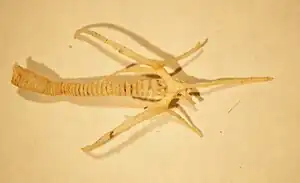_(14771939372).jpg.webp)
The hyoid apparatus of a horse. A–D: hyoid apparatus (D: basihyoid), E: epiglottis, F: glottis, G–J: cartilages of the trachea.

Hyoid apparatus of a leopard gecko, Euplepharis maculatus, with attached tracheal rings (ventral view, anterior towards the right)
The hyoid apparatus is the collective term used in veterinary anatomy for the bones which suspend the tongue and larynx.[1] It consists of pairs of stylohyoid, thyrohyoid, epihyoid and ceratohyoid bones, and a single basihyoid bone.[2] The hyoid apparatus resembles the shape of a trapeze,[3] or a bent letter "H".[4] The basihyoid bone lies within the muscle at the base of the tongue.[1]
In humans, the single hyoid bone is an equivalent of the hyoid apparatus.[5]
References
- 1 2 König, Horst Erich; Liebich, Hans-Georg, eds. (2007). "Skeleton of the head". Veterinary anatomy of domestic mammals textbook and colour atlas (3rd ed.). Stuttgart: Schattauer. p. 71. ISBN 978-3-7945-2485-3.
- ↑ Thrall, Donald E.; Robertson, Ian D. (2011). "Chapter 2. The skull". Atlas of normal radiographic anatomy & anatomic variants in the dog and cat. St. Louis: Elsevier/Saunders. p. 37. ISBN 978-1-4377-0178-4.
- ↑ Aspinall, Victoria; Cappello, Melanie (2009). "Chapter 3. Skeletal system". Introduction to Veterinary Anatomy and Physiology (2nd ed.). Butterworth Heinemann. p. 33. ISBN 978-0-7020-2938-7.
- ↑ Colville, Thomas P.; Bassert, Joanna M. (2016). "Chapter 7. The skeletal system". Clinical Anatomy and Physiology for Veterinary Technicians (3rd ed.). St. Louis: Elsevier. p. 188. ISBN 978-0-323-22793-3.
- ↑ "Hyoid apparatus - Definition". mondofacto.com.
This article is issued from Wikipedia. The text is licensed under Creative Commons - Attribution - Sharealike. Additional terms may apply for the media files.